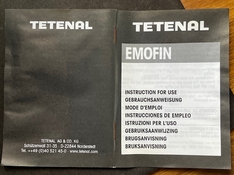Here's a quick sample calculation to more fully explain what I meant in my last post. In this sample calculation I will not be discussing developer molecules that are in the emulsion itself, only those that are in the liquid residue clinging to the reels and walls of the development tank.
Suppose you are using 500 ml of developer and that in that 500 ml there are 10,000 developer molecules. Yes, I know there are more than that. I'm just using that number to make the calculations easy for illustration purposes.
Assume that after the development stage is completed you pour out 495ml of the developer solution, leaving 5ml clinging to the reels and walls of the tank. That's 1% of the original volume. In that 1% there will be 100 molecules of developer. (1% of 10,000 molecules is 100 molecules.) At this point I will split the analysis into two scenarios.
In scenario one we add 495ml of water to the tank and agitate to mix it with the 5ml of residue from the previous step. There will be 100 molecules of developer in the 500ml of resulting solution. We pour out that solution, leaving 5ml of residue in the tank. In that 5ml there will be an average of 1 molecule of developer. That's the number of developer molecules carried over into the fixer.
In scenario two we add 495ml of acid stop bath into the tank and agitate to mix it with the 5ml of residue from the previous step. There will be 100 molecules of developer in the 500ml of resulting solution. We pour out that solution, leaving 5ml of residue left in the tank. In that 5ml there will be 1 molecule of developer. That's the number of molecules carried over into the fixer. That's exactly the same number of developer molecules carried over as in scenario 1.
If you started with the a different number of developer molecules the carryover ratios will be the same as those described above. For example, if you started with a 100 trillion molecules in 500ml of developer you end up with 10 billion developer molecules carried over into the fixer, regardless of whether you were using a water stop bath or an acid stop bath. The carryover ratio is 0.01% of the original number of molecules.
Suppose there was 10ml instead of 5ml of solution carryover for each step. That would change the fraction of molecules carried over into fixer from 0.01% to 0.04%, independent of whether you use an acid stop bath or a water stop bath.
Conclusion: the number of molecules carried over into the fixer is independent of whether one uses an acid stop bath or a water stop bath.
As noted above, this analysis does not include a discussion of developer molecules that are actually trapped in the gelatin at the beginning of the stop-bath step. However, to argue that an acid stop bath produces less carryover into the fixer one would somehow have to say that, first of all, there are enough developer molecules trapped in the gelatin to matter (which I think it unlikely), and second of all, that an acid stop bath is more efficient in extracting those molecules into solution than a water stop bath, which as far as I am aware has never even been discussed, let alone been proven.







